For International Nurses’ Day, we want to celebrate the wonderful diversity of roles that are on offer to those who want to pursue a career nursing in the community.
To showcase community nursing in 2018, there is no better way than to highlight some of the work of the first cohort of Queen’s Nurses who were awarded their title just six months ago – marking the return of Queen’s Nursing to Scotland for the first time in almost 50 years.
The three nurses featured work in settings not often in the spotlight – there’s a nurse working in school nursing, another who works as a Parish nurse caring for homeless people, and another nurse working as a respiratory specialist across an area almost the same size of Belgium.
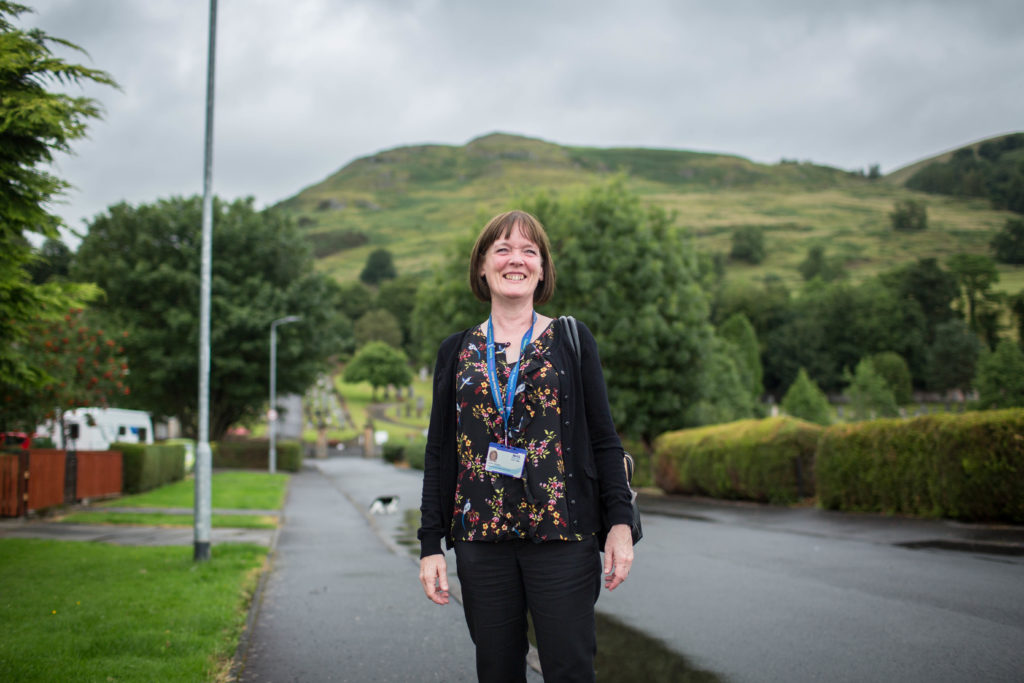 The welfare of children has always been close to Joan Gracie’s heart, and as Team Leader for School Nursing in NHS Forth Valley, she feels she is making a real difference. “There are so many young people in need of help,” she says. “Here we are determined to see they get it, hopefully at an early stage.”
The welfare of children has always been close to Joan Gracie’s heart, and as Team Leader for School Nursing in NHS Forth Valley, she feels she is making a real difference. “There are so many young people in need of help,” she says. “Here we are determined to see they get it, hopefully at an early stage.”
Joan manages the school nursing service in Stirling and Clackmannanshire, and oversees a team made up of a Health Care Assistant, a family support worker, two counsellors and 10 Staff Nurses. Between them they offer support to around 500 families a year. “We mainly work with children and young people for whom there are emotional and behavioural issues,” says Joan. “We spend time with them and their families to unpick what that’s about.”
When she came into school nursing from health visiting in 2007, Joan was struck by the need for modernisation. “It was the traditional medical model, nurses doing clinics and seeing to the routine physical health needs of children and young people,” says Joan. “I could see that change was required.”
The following year, Clackmannanshire School Nursing Service was selected as a pilot site for the Scottish Government’s Health and Wellbeing in Schools project, which came with the resources to create a gold-star service. “It offered an opportunity to do something different, to build capacity and partnership working, and think strategically,” says Joan
Bringing together all sectors – the education department, youth services, social services and charities – Joan and her team established a way of working that evaluated strongly. But when recession hit in 2010, funding fell away and many staff went back to their substantive posts. Undeterred, Joan resolved to rebuild the service with reduced resources. “The team got together and we thought about what we could do,” she says. “The way we work now is the result.”
The nurses on the team have received additional training to support children and families with the most complex needs, and they work closely with partners in the local authority and third sector to enable working together in more meaningful ways. “We gradually altered things to focus on the most vulnerable,” says Joan. “We can now show that most of the children, young people and families we work with have achieved significant progress.”
The service works with children with emotional and behavioural problems, those who have experienced domestic abuse, young carers, children on the child protection register, children who are looked after at home, children who are affected by substance misuse, homeless families, and others involved in the youth justice system. “It’s a long way from school nursing of the past,” says Joan. “The challenges children and young people are facing now are significant.”
The school nursing team is dealing with unprecedented demand for psychological support. Young people everywhere are under stress, and rates of low mood, anxiety and self-harming are high.
The team runs confidential, multi-agency, school based drop-in sessions on a weekly basis, “We ask the young people what they want, and make it happen,” says Joan. “It’s important they own the service we offer, and let us know if it is meeting their needs.”
When a child comes to the team’s attention, maybe referred by a teacher, a parent, or sometimes by the child themselves, the nurses make contact and arrange to meet.
“We ask the young people what they feel they need and then we work with them to make it happen,” says Joan. “It’s important they own the service we offer, and that they can let us know if it is meeting their needs.”
“Giving support to parents who are going through difficulties with their children is another key role. Parenting is complex and challenging and working with families to overcome obstacles is one of our core functions.”
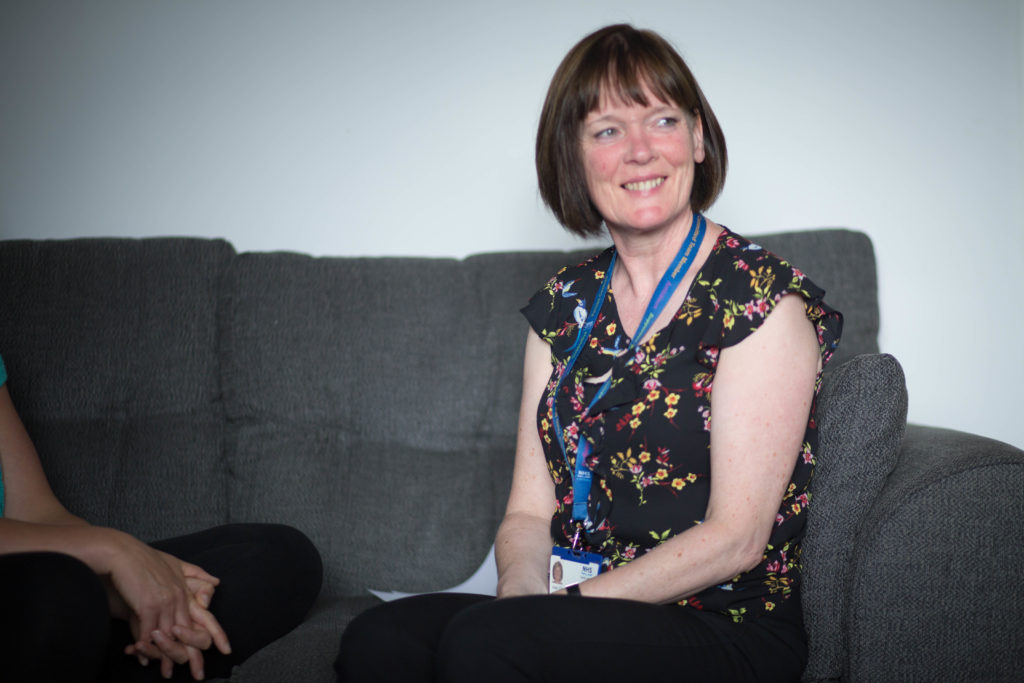 Joan regards the Queen’s Nurse title as a great honour. “I feel very inspired and enthused by the values that underpin Queen’s Nursing,” she says. “It’s an affirmation of what I do, and encouragement to be braver and bolder with it. I am much more confident about using words like ‘love’ and ‘kindness’ now.”
Joan regards the Queen’s Nurse title as a great honour. “I feel very inspired and enthused by the values that underpin Queen’s Nursing,” she says. “It’s an affirmation of what I do, and encouragement to be braver and bolder with it. I am much more confident about using words like ‘love’ and ‘kindness’ now.”
As part of her induction as a Queen’s Nurse, Joan has been undertaking a project to enhance holistic care in a particular area. She is focusing on the needs of children who are looked after at home under a supervision order, a group of young people who have even worse health outcomes than children who are looked after in other settings. “They are not so visible, often not at school,” she says. “But if we can reach out to them, we can give them the help they need to see them through turbulent times.”
To build the skills of her team to cope with growing demand and increasing case complexity, a new skills pathway for school nursing is being embedded. One Staff Nurse is completing an MSc in Public Health Nursing, and Joan hopes others will follow.
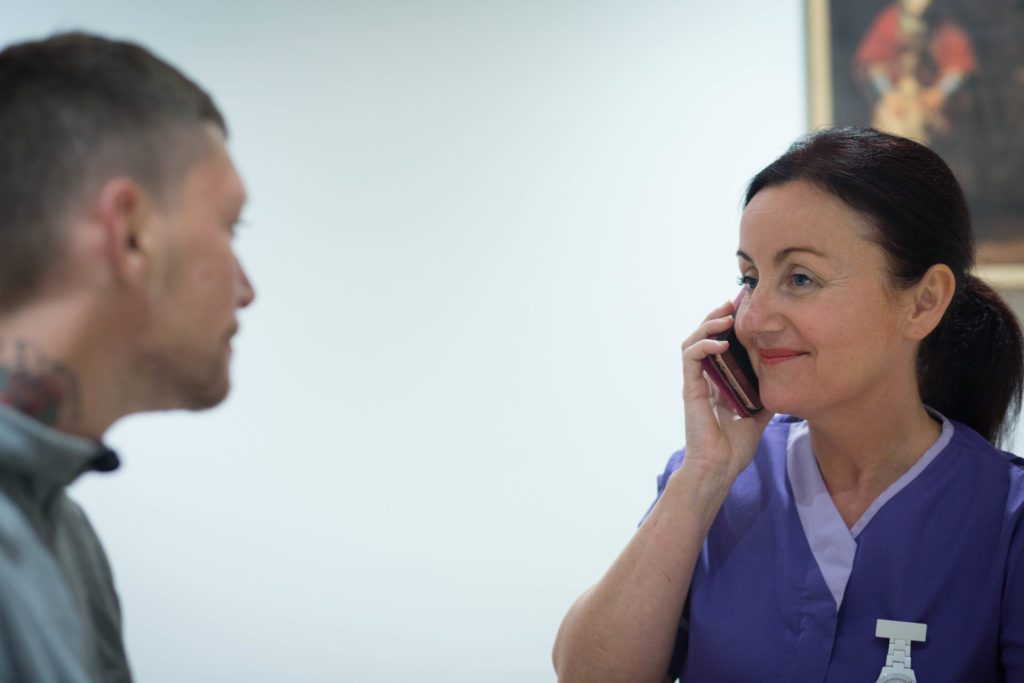 To Cheryl Ferguson, Dundee’s Steeple Church Parish Nurses are “my wee adopted mammies”. To others, they are problem-solvers, shoulders to cry on, and even life-savers.
To Cheryl Ferguson, Dundee’s Steeple Church Parish Nurses are “my wee adopted mammies”. To others, they are problem-solvers, shoulders to cry on, and even life-savers.
“They’ve done a lot for me and every single person who comes through this door,” says Cheryl. “I really don’t think I’d be here now if it wasn’t for them. I’d be in a box.”
Cheryl is back for a visit to the drop-in clinic at The Steeple Church that she once regarded as a lifeline. Now she has a story of recovery to share. “I was described as a lost cause, but I have proved them all wrong,” she says. “I want people like myself to know there is someone out there they can ask for help. A lot of them never expect it.”
Parish Nurses Rachel McReady, Barbara Macfarlane and Kirsty Watt provide a service for people who are experiencing homelessness, poverty, and a wide range of problems. At the Drop-in Clinics that they run twice each week they try to help with health issues and give support where it is required. “Folk often have difficulty accessing the help they need,” says Rachel. “We offer time, genuine love and care and a helping hand alongside our nursing skills. It is important that this is a safe place for them.”
Parish Nursing is charity that operates through churches and Christian organisations across the UK. The Steeple service was set up nine years ago, and is the only one in Scotland working specifically with people affected by homelessness, which includes rough sleepers, people living in temporary hostel accommodation, those who may be sofa-surfing, and people whose tenancies are vulnerable due to mental health problems and other challenges.
Some are struggling with addictions to alcohol, drugs, gambling; some because of adverse childhood experiences, post-traumatic stress disorder, leaving the armed forces or coming out of prison.
“It can be difficult to get medical and other appointments, and for some of our folk it is even harder if they don’t have phones or money to get to appointments,” says Rachel. “When they have health problems they may be put off seeking medical help.”
The Parish nurses help to make vital appointments for people and will attend with them if they require the additional support. They also refer individuals to many other services within the city . “Parish nurses describe their role as ‘walking with people on their health journey’.”
Around 30 people attend each drop-in clinic, and while the Parish Nurses are assessing health needs and listening, a team of volunteers is serving warm, welcoming, healthy food.
“Some of the volunteers originally came for help themselves and are now recovering, really trying to turn their lives around and move forward,” says Rachel. “They learn skills and are part of a very caring team, which in itself is a positively life-building opportunity.”
Health promotion is a key part of the Parish Nurse service, preventing conditions from worsening by involving all the help that a person needs. “It doesn’t matter whether it’s a problem with a wound, depression, toothache, benefits sanctions or a housing problem,” says Rachel. “They are all equally important in person-centred care. Folk need a more holistic approach to assist them with their health and social needs.”
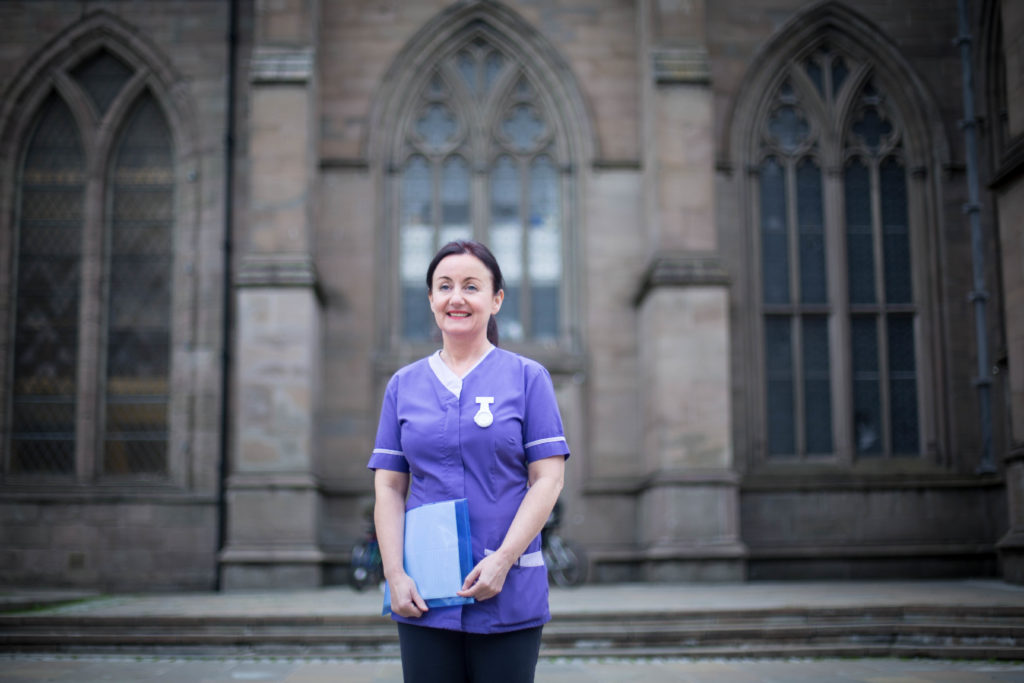 The Parish Nurses have close links with Dundee City Council’s welfare advice team, Connect, whose staff help with benefits queries, referrals to the Food Bank, and to harm reduction and other relevant services. And the NHS community Dental Team brings its mobile surgery to the city-centre church each week.
The Parish Nurses have close links with Dundee City Council’s welfare advice team, Connect, whose staff help with benefits queries, referrals to the Food Bank, and to harm reduction and other relevant services. And the NHS community Dental Team brings its mobile surgery to the city-centre church each week.
As Christians, the Parish Nurses care for people of all faiths and none. “Folk often speak of how lonely they are, how they feel they don’t matter to anyone or belong anywhere, there’s no sense of hope or purpose,” says Rachel. “Problems cannot always be fixed, but sometimes a prayer can give a wee injection of courage and hope, and all the more so if it’s accompanied by a hug.”
Rachel is one of 20 nurses taking part in the new Queen’s Nursing Institute Scotland’s development programme, which promotes excellence in community nursing. She won her Queen’s Nurse title, one of the first to be awarded in almost 50 years, for her heartfelt commitment to improving care for people who are very marginalised by society.
Having trained as a nurse in Dundee, Rachel worked in Ninewells Hospital for 15 years in orthopaedics, surgical and haematology wards, and then in the community anticoagulant team. “It was then I realised that community work was where my heart lay,” she says.
She took a part-time post with the NHS Health and Homeless Outreach Team, which works in partnership with Parish Nursing in Dundee. When a complementary part-time position came up there, Rachel jumped at it. “Having a foot in both camps presents some challenges, but on balance it brings many benefits for both services,” she says. “Parish Nurses play a very supportive role alongside their professional colleagues both in health care and other relevant agencies, without duplication.”
As part of her Queen’s Nurse development programme Rachel is undertaking a professional challenge: to bring together relevant statutory, voluntary and other small organizations.
“Hopefully this will encourage us all to work closer together so that a more supportive, effective and co-ordinated way can be used in order to develop a more community based person-centred recovery journey.”
“By working together we can break down some of the traditional barriers and continue to build bridges of hope for people in our community.”
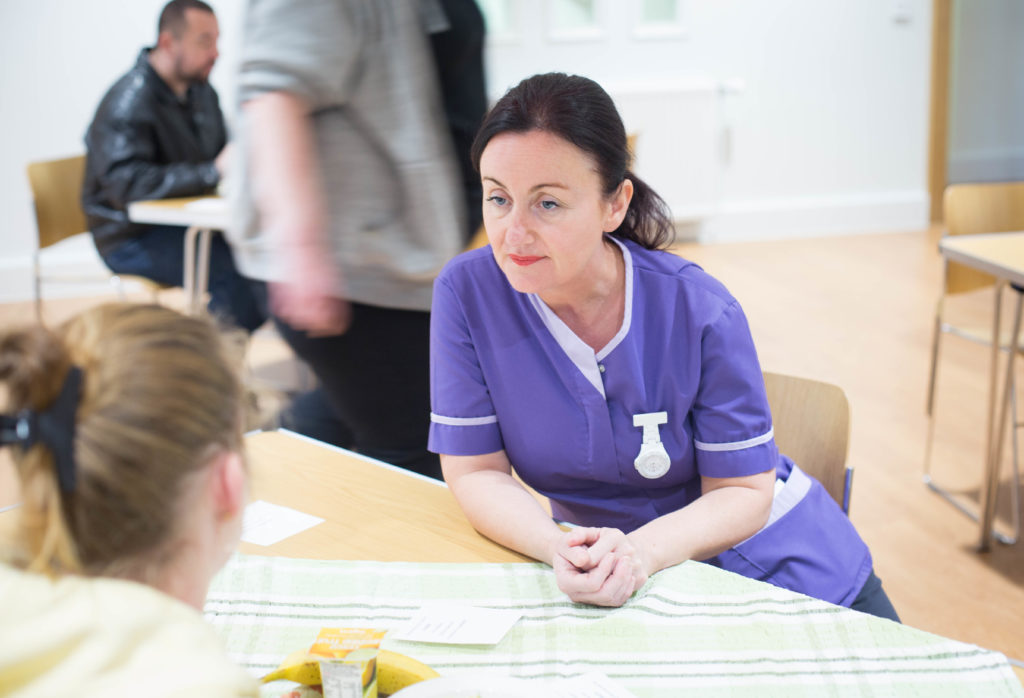 For Hazel Douglas, Senior Staff Nurse with the Health and Homeless Outreach Team, the Parish Nurses’ approach is special. “We hear words such as love, care, worthiness and hope, and the response by our guys is remarkable. So much so I have adopted this approach myself,” she says. “Although I have always holistically attended my patients I have personally learned so much more as a spiritual being. The Parish Nurses are very special, and to me they are the very heart of our city.”
For Hazel Douglas, Senior Staff Nurse with the Health and Homeless Outreach Team, the Parish Nurses’ approach is special. “We hear words such as love, care, worthiness and hope, and the response by our guys is remarkable. So much so I have adopted this approach myself,” she says. “Although I have always holistically attended my patients I have personally learned so much more as a spiritual being. The Parish Nurses are very special, and to me they are the very heart of our city.”
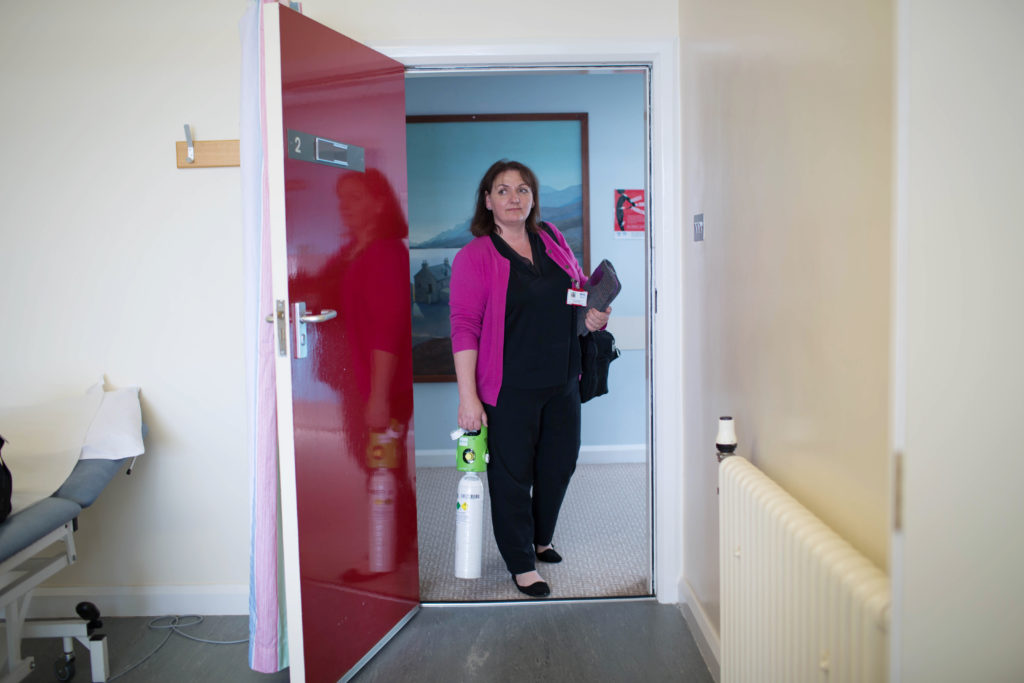 Michelle Duffy has one objective – to ensure that people living with disabling breathing problems in some of the most far-flung parts of North West Scotland can receive the same high quality evidence-based care as their counterparts in towns and cities.
Michelle Duffy has one objective – to ensure that people living with disabling breathing problems in some of the most far-flung parts of North West Scotland can receive the same high quality evidence-based care as their counterparts in towns and cities.
It may sound simple but Michelle, an Advanced Practice Respiratory Nurse with NHS Highland, operates across an area almost the size of Belgium. From her base in Inverness, she covers Caithness, Sutherland, Skye, Lochalsh and Lochaber, offering specialist nursing care and advice. Her patients, currently 150 people with severe respiratory problems, live scattered over many thousands of square miles.
Most of the people on Michelle’s caseload are elderly and have conditions such as chronic obstructive pulmonary disease (COPD), pulmonary fibrosis, emphysema and bronchiectasis, which make it difficult to breathe.
“There are few fancy tools we can use, or operations we can give, and limited medication, so we have to work with people to manage their symptoms,” says Michelle, who encourages her patients to stop smoking and to keep active, and works with others on the healthcare team, including physiotherapists, to reinforce breathing control techniques. “Life can be very difficult for people who are struggling with breathlessness every day, but there are many things that can make life easier. I’m very fortunate to be able to spend a bit more time with patients, which helps when it comes to listening to how they feel.”
Since it started eight years ago there is evidence that the nurse-led service is improving the quality of care people receive, extending their lives, and giving them back control. In addition, Raigmore Hospital in Inverness has noticed a reduction in emergency admissions, and there are fewer ‘blue-light’ calls.
The impact is attracting international interest: In September, Michelle and two colleagues presented at the European Respiratory Science conference in Milan, on the COPD Discharge Care bundle. Devised in Caithness General Hospital and adopted by Raigmore, this approach has been a part of helping cut in-patient stays by half. “Investing in good care in the community is sound common sense,” she says. “We need to be able to support people to manage their condition at home, helped by the whole community healthcare team.”
Recognising and supporting innovation in community nursing practice is the purpose of Queen’s Nursing Institute Scotland, which has recently appointed its first Queen’s Nurses in 50 years. Michelle is one of them, and she is looking forward to using the title to help her influence change. “Pulmonary rehabilitation is a service that really works, and yet there’s evidence that we’re only reaching 8% of the people who might benefit,” she says. “More GPs need to refer to rehab early, and I want patients everywhere to be asking, ‘why can’t I get that service too?’”
Michelle, who lives on the Black Isle with her husband and two teenage children, worked with respiratory patients when she was based on the wards at Raigmore.
When the opportunity came up to develop community-based pulmonary rehabilitation in Invergordon, Michelle went for it. “It was just the best thing that ever happened,” she says. “I was fortunate enough to be working with a team that was interested in self management, and I felt I had the support and permission to go and see how we could make things better in the community.”
Working with patient representatives, GPs and other colleagues, and borrowing from best practice elsewhere, Michelle developed COPD ‘traffic light’ self-management plans. Patients now hold their own record cards, which helps them to follow their exacerbation patterns. This encourages them to see when they are doing well and to recognise early warning signs. So successful are the plans that the charity Chest, Heart and Stroke Scotland (CHSS) now uses the same model nationwide.
Michelle spends a great deal of her time travelling to different centres across the north west Highlands, running clinics and making home visits. The first Tuesday in the month is spent in Golspie and today, having completed her clinic at the town’s Lawson Memorial Hospital, she is dropping in to see a new patient. 87-year-old Allan has one-and-a-half lungs because of childhood pneumonia, and suffers from bronchiectasis, which has been deteriorating recently.
Following a recent visit, Michelle arranged for oxygen to be provided for Allan at home. Today she is doing a follow-up assessment, including an arterial blood gas test, to check how he is doing. Until recently, that would have involved a 50-mile round trip to hospital, but Michelle has equipment that allows her to do it on-the-spot.
“Inverness is a long, long way to go for tests and check-ups, and I find the journey extremely difficult,” he says. “Michelle comes to me and sees to my respiratory needs. She has got things underway for me that are certainly helping, like the oxygen. I use that as much as I can.”
As an Advanced Practitioner and specialist respiratory nurse, Michelle can assess, prescribe and treat. She has a direct line to doctors in Raigmore Hospital if she needs advice, and operates autonomously the rest of the time. “It is a really rewarding role,” she says. “I am pushing out the boundaries of nursing practice in this field, and the patients really like being cared for closer to home.”
Michelle makes a point of regularly checking the experience of the people she works with, including carers. She sends out questionnaires, and takes part in national surveys; she’s involved in setting up an NHS Highland patient engagement forum, Breathing Matters, along with the local CHSS Voices group, which offers education and peer support. “We need to know where the people who use it want to take the service, not assume that we know best,” says Michelle. “That’s how I see change happening – from the front.”
Most of Michelle’s patients are referred by the hospital or GPs. And when it comes to diagnosis, there is an enormous difference between rich and poor. “We know that the greatest burden of respiratory disease is in the most deprived communities, yet these patients don’t often go to pulmonary rehab, and we need to understand why,” says Michelle. “They don’t go to see their GP so much, and if they have been a smoker, they tend to think they’ve brought it upon themselves and deserve it. I want them to know that’s not the case.”
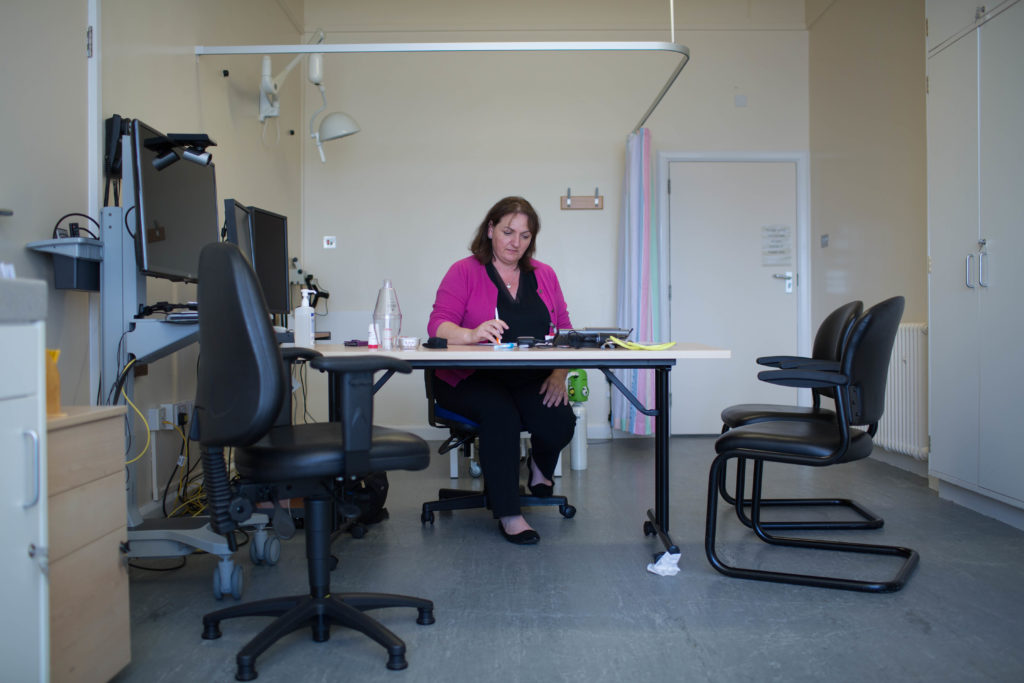 Working closely with national charities, as well as community-based support groups, Michelle raises awareness of respiratory disease, and the importance of early diagnosis. They take their spirometer, for measuring lung capacity, into supermarkets and shopping centres to offer on-the-spot tests, and use every opportunity to spread the word. “This area has a lot of people who used to work in heavy industry, and were exposed to environmental causes of lung disease,” she says. “If they spot the signs and start treatment quickly, their prospects of living well for longer are significantly improved.”
Working closely with national charities, as well as community-based support groups, Michelle raises awareness of respiratory disease, and the importance of early diagnosis. They take their spirometer, for measuring lung capacity, into supermarkets and shopping centres to offer on-the-spot tests, and use every opportunity to spread the word. “This area has a lot of people who used to work in heavy industry, and were exposed to environmental causes of lung disease,” she says. “If they spot the signs and start treatment quickly, their prospects of living well for longer are significantly improved.”
Rehabilitation is Michelle’s most powerful tool. She works with patients one-to-one to set goals and devise exercise programmes, supporting lung function and overall strength. “Each person is different,” she says. “One of my patients is now cycling five miles a day, but for others managing a walk into the kitchen can be enough. It’s keeping active that’s important, and whatever they can manage helps.”
People who don’t go to rehab are many times more likely to need unscheduled care because of severe exacerbations, so Michelle has encouraged the setting up of pulmonary rehab classes in many communities. To complement them, local groups are springing up too, offering tai-chi, singing and Scottish country dancing for people with respiratory illnesses.
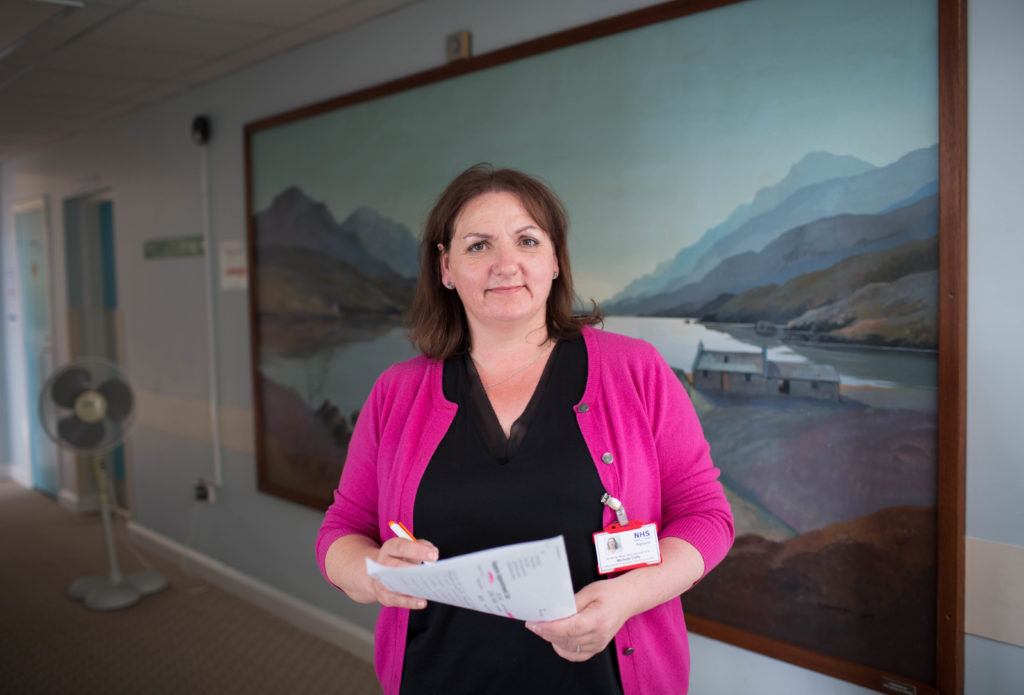 As she drives around the Highlands, Michelle marvels at the scenery and remembers what it was like to be on a ward doing a 12-hour shift. “On a beautiful day it’s lovely,” she says. “But looking to the future, I hope I won’t have to spend four hours in a car to connect to my patients. The more we can use technology, the better.”
As she drives around the Highlands, Michelle marvels at the scenery and remembers what it was like to be on a ward doing a 12-hour shift. “On a beautiful day it’s lovely,” she says. “But looking to the future, I hope I won’t have to spend four hours in a car to connect to my patients. The more we can use technology, the better.”
Michelle would love to see the day when the IT infrastructure would be reliable enough to allow her to run virtual clinics in patients’ own homes from Inverness, using teleconferencing. But poor internet coverage and clunky connections mean that is still some way off.
Various telehealth approaches for COPD have been tried here over the years, and there is a trial taking place to evaluate the mobile phone-based reporting system, Florence Light Touch, which allows patients to send daily updates electronically. “Most people really like it, and it encourages them to take control of their condition,” says Michelle. “Ideally the system would be personalised to the individual. It’s all about putting people in control of their condition.”
When she is at Caithness General hospital in Wick, Michelle uses videoconferencing to run a multi-disciplinary clinic with Lorna Murray, a respiratory consultant at Raigmore, saving patients the three-hour round trip to Inverness. “It’s a great development, because I am learning more about diagnosis, and the patients like the fact that I can carry out the clinical assessment and translate the doctor-speak for them,” she says. “We all work very well together.”
In Caithness, Michelle works also with a newly-appointed respiratory nurse, Mahri Swanson, and other healthcare practitioners, sharing her knowledge and skills. Across her area, she works closely with the local community nurses and GPs who see and manage patients between her visits. “I think one of the most valuable aspects of my role is to share specialist knowledge with the whole multi-disciplinary team,” she says. “Managing respiratory disease well is everyone’s business, and I am keen to share what I know.”
Across Scotland, the number of people living with respiratory disease is increasing, and Michelle is committed to doing whatever she can to make sure that they all receive the standard of care that she gives her patients. To that end, she sits on the Scottish Parliament’s cross-party lung health group, and she will be using her Queen’s Nurse title to get her message across. “We are helping to shape how the service should look right across the country,” says Michelle. “It’s very exciting that NHS Highland is showing the way.”
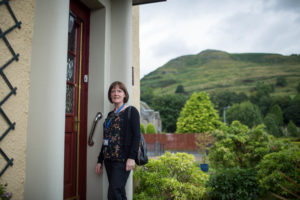
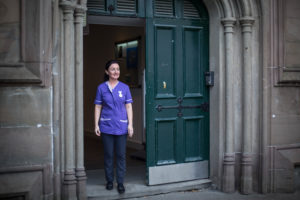
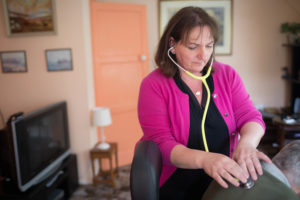
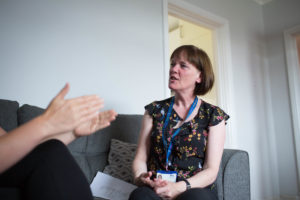
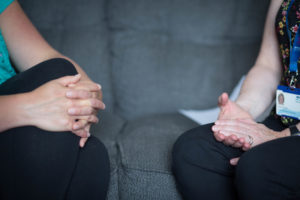
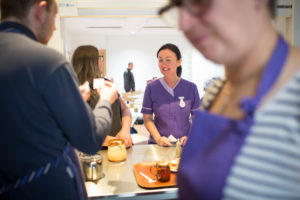
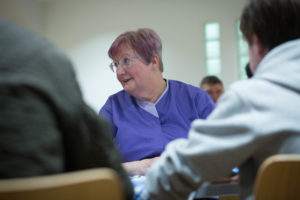
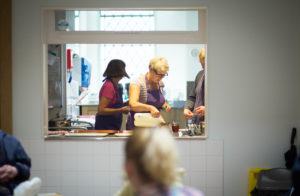
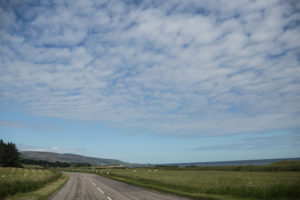

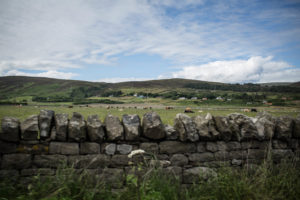
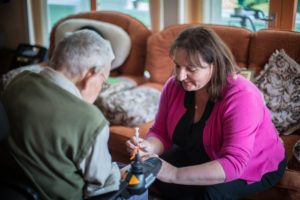
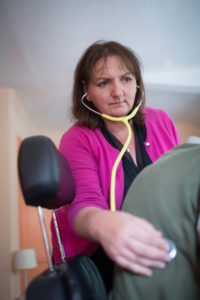
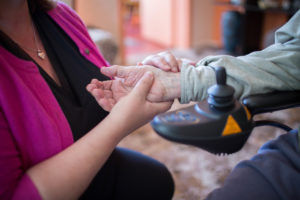
Leave a Reply